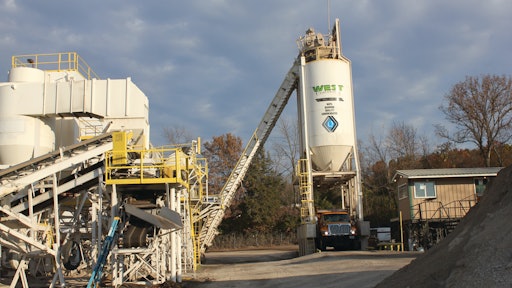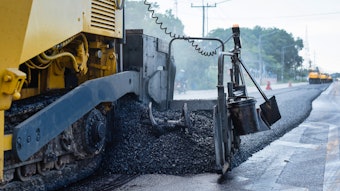
A recent survey by the National Asphalt Pavement Association (NAPA) showed that state governments and agencies are increasing the adoption of sustainable technologies such as reclaimed asphalt pavement (RAP) nationwide. The survey stated that 66.7 million tons of RAP were collected in the United States during 2011 for use in new pavements.
The amount of RAP used in a given mix design is usually spelled out in state specifications, yet there are some asphalt projects in the state of Missouri that are pushing the envelope and using high RAP mixes (up to 50% and more).
West Contracting, headquartered in St. Louis and with asphalt plants in Sullivan, House Springs, and Pacific, MO, has had the opportunity to provide mix for several projects using high RAP content.
Steve Jackson, PE, technical manager for West Contracting, feels we are just seeing the beginning of high RAP mixes. "The asphalt industry has been using recycled products for decades to improve our roads," he says. "In the short term, with decreasing highway funding to the states, using more RAP in asphalt pavements will provide a more economical way to meet the growing demands for infrastructure rehabilitation and improvement. In the long term, I think that a 100% recycled asphalt pavement that does not require heat is achievable."
There are several benefits to high RAP mixes, including decreased demand for virgin aggregates and new asphalt binder. But there are many considerations if you're planning on running high RAP mixes at your plant.
Producing the RAP
The best way to get a quality product is to start at the beginning, so if your milling crews are producing the RAP, emphasize the importance of maintaining a constant quality when milling.
"A consistent feed of millings is also going to make it easier to minimize the dust while screening or crushing the millings," says Jackson.
If you can, screen your millings you can minimize the amount of dust generated compared to crushing the millings. "We are lucky to work with Doug Hill at Aggrecon Crushing and Recycling and his experience crushing millingsallows us to use our oversized clean millings to produce a consistent crushed RAP that matches our screened RAP."
Be aware of felt fabric, says Jackson. Felt fabric that is placed between layers to aid with crack propagation can become a problem when you start to crush your millings. "It can build up on the crushing unit and have to be cleaned off," he says. "The fabric can also become wrapped around some of the moving parts on the crusher and cause them to lock up."
Handling the RAP
When you use high percentage of RAP in an asphalt pavement it becomes critical to handle the RAP in a way that won’t lead to segregation, says Jackson.
"Fractionating the RAP into different sizes will give you better control over the volumetric properties of the mix," he explains. "When we started using Superpave in the mid 1990s, we started using more fractions of aggregate to give us better control of the mix and to optimize our mix designs. The same principles apply to RAP."
If a contractor uses millings or a single, unfractionated RAP as 50% of the aggregate in a mix, then there will be a large amount of variation in the field volumetrics. "Many contractors have the skill to handle this variation, but it takes a lot of work," says Jackson. "Fractionating the RAP shifted that workload to the off season when we can characterize the stockpiles better instead of reacting to problems on the job."
The screens that you choose to fractionate your RAP on will be determined by the work demand in your area. If your local market is focused on thin lift overlays then you do not need a lot of 1” clean RAP.
"If you find that you have a surplus of a particular size you may choose to crush the larger fractions into sizes that have a higher demand," says Jackson.
Stockpiling materials
Dry products require less energy to heat. At a minimum, Jackson recommends stockpiling your materials on a sloped area so that the water can drain out of the stockpiles.
Other considerations for stockpiling:
- Pave your storage area helps reduce stockpile loss, avoid contamination from mud, and allow for better drainage
- Cover your RAP stockpiles to keep them dry if you can
- First In - First Out: If only one end is open, you are constantly adding wet material to the front of your stockpile and the dry material is not getting used.
"After a rain event you will lose production if you do not have a well-drained storage area," says Jackson. "RAP will not drain as fast as clean, virgin aggregate."
Drying the RAP
Trying to super heat the virgin aggregates to dry out the RAP can cause some very high stresses in the plant leading to increased maintenance, loss of production and a shorter life on your critical wear parts, such as the drum shell, tires and trunnions.
"I've had colleagues tell me that they have recorded shell temperatures of 1,200° F," says Jackson. "We have been running warm mix using Evotherm 3G for the last four years and have noticed a decrease in temperature induced wear in our plants."
The Evotherm 3G also allows West Contracting's road crews to achieve density easier so they are not telling the plant operators to turn up the heat because they cannot get compaction, explains Jackson.
"At the plant we save burner fuel and save wear on the plant," he says. "Using warm mix is essential for producing the most economical high RAP mixes. One thing that we have noticed when using a surfactant warm mix additive is that some residual moisture increases the efficiency of the warm mix additive. Since the product is an adhesion promoter, the residual moisture does not promote stripping."
In addition to reducing heat-related damage to your plant, using warm mix with a high RAP content helps combat stiff binders, says Jackson. "You're not heating the virgin or reclaimed binder as much," he says.
Plant component considerations
In addition to high heat issues, there are other components on your asphalt plant that need some considerations during production of high RAP mixes.
For example, RAP collars on older plants were probably designed to utilize 10-20% RAP. "As a result when you try to make the move to higher RAP utilization then the collars can plug, especially with wet recycled materials," says Jackson. "We have found that by enlarging the openings on the inside of the drum and using a larger opening to feed the RAP into the drum helps solve this problem."
Moisture and dust is a contributing factor to clogged RAP collars. "Try to avoid having your dust return feed into the drum close to where the recycled materials enter the drum," suggests Jackson. "The dust will bind to the moisture in the RAP and cause your plant to plug up."
If you have both a drying drum and a mixing drum, then you don't have to have a RAP collar. "You can feed the RAP directly into the back end of the mixing drum," says Jackson. "It's easier to increase the amount of RAP in the mix and the large opening to feed RAP into the drum can be inspected easily by your ground person."
Flight adjustments in the drum are another consideration for high RAP mixes. "We have adjusted our flights in the drums over the years," explains Jackson. "A lot of what we have learned is through trial and error.
"We have found that working with the right people at the plant manufacturer is the best way to learn how to make adjustments to the flight," he continues. "I always recommend training, and the best training that I have had is at the Astec Advanced Customer Schools. We took what we learned there and modified our flights to our needs. It helps to have some great plant operators that can take what they have learned and figure out what is best for their plant."
Another component that can make a difference during production of high RAP mixes is the conveyor belt and the proper incline. "In order to add additional incline belts to the plant, where we are already constrained on space, we tend to make the incline belts steeper," says Jackson. "If the belt is too steep, then the large RAP aggregates tend to roll back down the belt toward the scalping screen."
Some final advice
While there are many benefits to offering a high RAP mix, producing a quality mix is always your top priority.
"It's nice to reduce the amount of virgin binder in the mixes through recycling, but make sure that the mix still performs well," says Jackson. "Err to the conservative side when you are determining the asphalt content of your RAP. It will be easier to maintain a quality product if you have too much oil in the mix, that can be adjusted down, than having a dry mix. Besides you look a lot smarter when you can tell your boss that we can take some asphalt binder out instead of having to add a few tenths of oil to make the mix work."
Partnering is essential to make high RAP mixes successful. Working with the state department of transportation, state asphalt pavement association, municipalities and industry suppliers is essential to bring new technologies to the market that will yield long lasting, sustainable pavements, says Jackson.
"Right now, it's difficult to ask a DOT or municipal highway department to try something new since they are looking at making tough decisions with the limited funding that they have," he says. "You have to provide them with performance data, cost savings and some assurances that this idea will work. A DOT that is willing to take some risk in trying something new may find that they are receiving a substantial financial windfall in the long term."



























